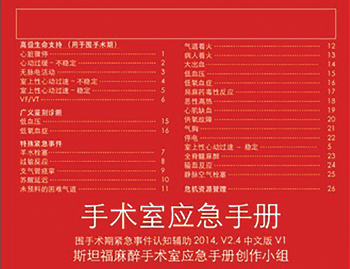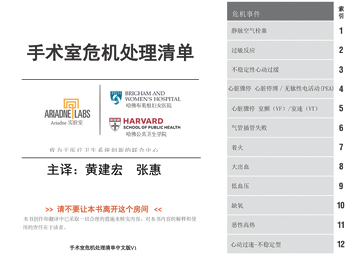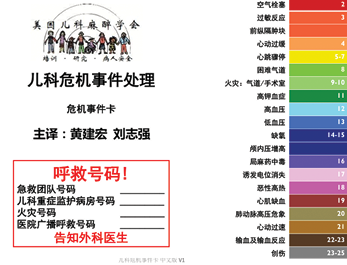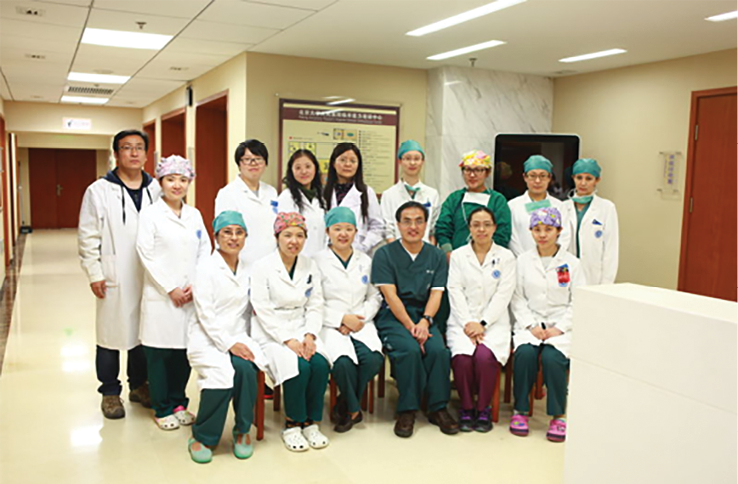Implementation of Emergency Manuals in China
Jeffrey Huang, MD

Cover page of Stanford Emergency Manual translated into Chinese.
In aviation and nuclear power industries, emergency manuals have proven to be helpful tools during critical events. These emergency manuals are integrated into training, and are expected to be used whenever they are needed.
Gawande’s The Checklist Manifesto emphasized that perioperative checklists improved surgical safety.1 The evidence proved the value of using checklists in medicine. Gawande et al. published a study result in the New England Journal of Medicine.2 Implementation of the World Health Organization surgical safety checklist reduced the mortality and inpatient complications rate significantly. In 2013, a simulation-based trial demonstrated that teams missed 6% vs. 23% of critical actions during a variety of operating room critical events when emergency manuals were used versus not.3 In the United States, most institutions have gradually achieved significant cultural acceptance to integrate emergency manuals into their practice and training.
Permission to Translate
Can emergency manuals be implemented in other countries? Recognizing the importance of the implementation of emergency manuals, I contacted the Stanford Anesthesia Cognitive Aids Group, Harvard Ariadne Lab, and the Society for Pediatric Anesthesia to acquire the official permission for translating their manuals. All three organizations strongly supported my request and granted the permission. Leading developers of emergency manuals worked with me to support translation of these emergency aids under creative commons licenses.
Translation
Subsequently, two translation teams were organized. One team was led by Dr. Hui Zhang (Department of Anesthesiology, School of Stomatology, The Fourth Military Medical University, Xian, China). The other team was led by Dr. Zhiqiang Liu (Department of Anesthesiology, Shanghai 1st Maternity and Infant Hospital, Shanghai, China). Dr. Zhang’s team was responsible for Stanford Operating Room Emergency Manuals and Harvard Ariadne Lab Operating Room Crisis Checklists. Dr. Liu’s team was responsible for Society for Pediatric Anesthesia Pedicrisis Critical Events Cards. The teams were composed of anesthesiologists from their respective department and other institutes. The workload was distributed among the team members with each translator responsible for translating one to two pages. They were required to ensure that the translation was as accurate, precise and as fine-tuned as possible. Professional editors were hired to do editing for OR Crisis Checklists and Pedicrisis Critical Event Cards. The organization, format, color coding, and text size were mandated to be consistent with the English version. The Stanford Emergency Manual was edited by Stanford Anesthesia Informatics and Media Lab under the direction of Dr. Larry Chu.
Education
While the teams were working on translation, I traveled to China and did several presentations on the importance of using emergency manuals in the operating room. Presentations were made in the Zhejiang Province Anesthesia Quality Annual meeting. The presentation was recorded and aired in the New Youth Anesthesia Forum. Subsequently, I also presented in several hospitals, and at The Chinese Society of Anesthesiology (CSA) annual meeting in Xi’an. The presentations highlighted the importance and the upcoming availability of the Chinese versions of emergency manuals. The webinar presentation to the New Youth Anesthesia forum was viewed by more than 47,000 members.
Publication

Figure 2. Cover page of Harvard Ariadne Labs Crisis Checklist translated into Chinese.
 Figure 3. Society of Pediatric Anesthesia Pedicrisis Critical Event Card index translated into Chinese.
Figure 3. Society of Pediatric Anesthesia Pedicrisis Critical Event Card index translated into Chinese.
The New Youth Anesthesia Forum, the largest anesthesia network in China, is publishing three Chinese language translations of the emergency manuals. It has more than 127,000 registered members. The website director, Dr. Xianyong Zhou (Department of Anesthesiology, the 2nd Affiliated Hospital, Zhejiang University, Hangzhou, China), was personally responsible for the publication process. An introductory letter about the Chinese versions of the emergency manuals was created, and a separate web page was generated. The web page was designed to record how many copies of each book were downloaded. A feedback letter was generated for readers to make comments regarding the books and report successful implementation and use.
Metrics of Successful Implementation
Since all three books are free to download in the US, the Chinese versions are also free to download in China. We decided to publish on Christmas Day 2015 and offer the books as Christmas presents for Chinese anesthesiologists. New Youth Anesthesia Forum published the manuals on the website as the top news item for website registered members (http://xqnmz.com/thread-70751-1-1.html). In the meantime, New Youth Anesthesia Forum published this news on their mobile web for the members who used mobile devices. They can link to the downloaded site through their mobile devices. The New Youth Anesthesia Forum ensured that every member was aware of the publication.
These manuals are equally applicable for acute events in emergency departments, labor and delivery, medical, pediatric, and intensive care units. They can also be adopted for use in other hospital locations. To encourage other health care professionals to adopt use of the manuals, I also contacted a popular Chinese surgical website, obgyncn.com, resulting in rapid availability of manuals to surgical colleagues.
Within 6 months of publication, almost 125,000 copies have been downloaded. The actual distribution is likely much larger because many members received their copies by email and via social networking. The members highly appreciated the emergency manuals’ publication. New Youth Anesthesia Forum received many notes of gratitude from their membership.

Figure 4. Members of the first implementation workshop in Peking University People’s Hospital
Training
Experience with the WHO surgical checklist shows that just tacking a checklist on the wall doesn’t create effective use and subsequent positive change in team behaviors. According to the Emergency Manuals Implementation Collaborative (EMIC), availability of emergency manuals is not enough to improve performance. Training and familiarization are necessary to enable clinicians to become proficient in using emergency manuals.
Peking University People’s Hospital is one of the most prominent hospitals in China. The hospital has over 2,000 beds, and is located in the heart of Beijing. The hospital simulation center is the first Society of Simulation in Healthcare accredited simulation medical education center in China. The simulation center facility provides 1,300 square meters of space and access to state of the art simulation technology for health care training. The anesthesia department w
as determined to implement emergency manuals. The department chair, Dr. Yi Feng, strongly supports the implementation project. They printed out the books and kept one copy at each anesthesia station. They were also enthusiastic about establishing a train-the-trainer project. The project leader, Dr. Hui Ju, and I worked together to create detailed education material and organized a training program and are developing a simulation-based team-training curriculum to train participants in the simulation center.
The first implementation workshop was carried out on April 11, 2016, in Peking University People’s Hospital simulation center. About a dozen participants joined the workshop, with 50% of them coming from different areas and facilities. An introduction was presented as to why, how, and when to use emergency manuals. Scenarios demonstrated the importance of participant engagement. The participants engaged in their roles and team communication, and a simulation training session was demonstrated for all trainees. The same critical event was presented with and without the use of emergency manuals. This introductory demonstration simulation helps participants to witness relevant elements of team communication in a crisis and the use of an emergency manual. The demonstration will be aired on the hospital website as an implementation of emergency manuals education resource. A second implementation workshop is scheduled for April of 2017.
To assess the impact of the training on learner attitudes and knowledge, a survey form was developed. The participants were surveyed regarding their perceptions of the usefulness and clinical relevance of the emergency manuals on a scale of 1 to 5. The participants strongly believed that OR emergency manuals are excellent tools to learn how to manage OR crises and improve outcomes. They will use emergency manuals and will organize a local formal familiarization session in their hospitals.
Tongji Hospital, Tongji Medical College, and Huazhong University of Science & Technology are comprised of 52 clinical and paramedical departments with a total of 4,000 beds. Their anesthesia department has become one of the most prestigious anesthesia programs in China. Tongji Hospital has 70 operating rooms and performs about 70,000 anesthesia cases annually. The department chair, Dr. Ailin Luo, strongly supports the implementation of emergency manuals. Dr. Xianwei Zhang participated in the translation of the book, and organized implementation of emergency manuals. A group of anesthesiologists in the department were working on developing a training curriculum. They used a simple CPR mannequin and were able to create “realistic-enough” scenarios. The anesthesia department has a tradition of providing excellent education for its trainees. Their training curriculum can be used for the anesthesiologists from hospitals without a simulation lab.
Support From Official Organization
The Chinese Association of Anesthesiologists (CAA) is a division of the Chinese Medical Doctor Association. CAA is one of the largest anesthesiologists societies in China. The president of CAA, Dr. Weifeng Yu, supported the implementation of emergency manuals. The secretary of CAA, Dr. Zhijie Lu, arranged an implementation of emergency manuals presentation in the Congress of CAA. Based on the available evidence demonstrating the value of checklist use and team training, CAA encourages Chinese anesthesiologists to adopt the use of emergency manuals in the management of critical events with appropriate multidisciplinary training in their use.
The Chinese Society of Anesthesiology (CSA) is a branch of the Chinese Medical Association. The president of CSA, Dr. Lize Xiong, supported the implementation of emergency manuals and recommends that all Chinese anesthesiologists receive appropriate training and adopt the use of operating room emergency manuals with the goal of anesthesiologists being able to enhance their crisis management skills.
In Conclusion
Emergency manuals have been well received by Chinese anesthesiologists. Many hospitals have one copy at each anesthesia station. After multidisciplinary training, clinicians can become proficient in using emergency manuals. Chinese clinicians will achieve cultural acceptance to integrate emergency manuals into their practice and training.
Dr. Huang is a member of Anesthesiologists of Greater Orlando, a Division of Sheridan Healthcare and Associate Professor at the University of Central Florida College of Medicine and a member of the APSF Committee on Education and Training.
References
- Gawande, Atul. The checklist manifesto: how to get things right. New York: Metropolitan Books, 2010.
- Haynes AB, Weiser TG, Berry WR, et al. A surgical safety checklist to reduce morbidity and mortality in a global population for the Safe Surgery Saves Lives Study Group. N Engl J Med 2009; 360:491-499.
- Arriaga AF, Bader AM, Wong JM, Lipsitz SR, Berry WR, Ziewacz JE, Hepner DL, Boorman DJ, Pozner CN, Smink DS, Gawande AA. Simulation-based trial of surgical-crisis checklists.N Engl J Med 2013 Jan 17;368(3):246-53.


 Figure 3. Society of Pediatric Anesthesia Pedicrisis Critical Event Card index translated into Chinese.
Figure 3. Society of Pediatric Anesthesia Pedicrisis Critical Event Card index translated into Chinese.

 Issue PDF
Issue PDF